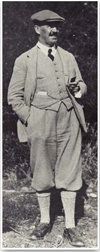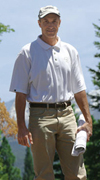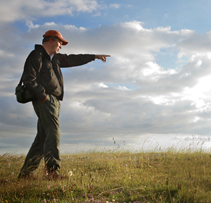Too Much of Good Thing…Is Not a Good Thing?
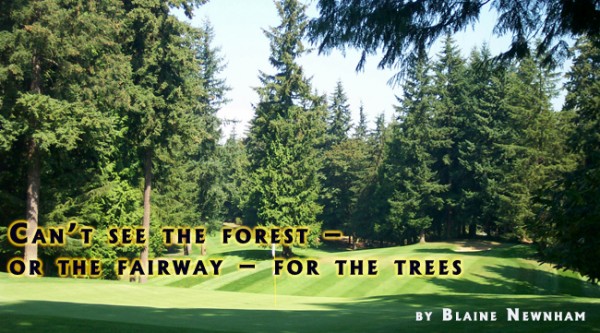
Views and opinions from our writers in Pacific Northwest Golfer Magazine
by Blaine Newnham
They are either the symbol of Northwest golf, or the curse.
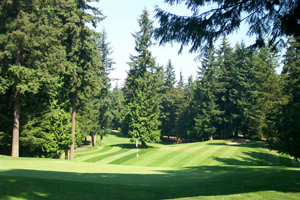 |
Sahalee Country Club is a classic Northwest course that was specifically designed by Ted Robinson with the trees in mind. Pictured is the par-4 7th hole on the North course. |
Trees.
You must have an opinion on them. Everybody does.
I’m at war right now with our greens superintendent over some small – soon to be large – trees he’s planted on the ninth hole.
He is trying to “protect the integrity” of a dogleg. Right now, the big boys fly shots over it.
In a few years, he contends, the trees will shape the hole, not the good players.
Too much, I think, is done for the good players, and not enough for the rest of us. But that’s another subject.
I think Chambers Bay has the right idea. It has one tree, and for all but aesthetic purposes, one tree is too many.
If you look back at the history of most courses, there was a time, in the ‘60s maybe, that planting trees was some kind of moral crusade. You know, trees lining every fairway.
Blame it on Lady Bird Johnson, the president’s wife, and her “Beautify America” project.
The best example of what’s gone wrong that I can think of is at the nostalgic and wonderful Pasatiempo course near Santa Cruz in Northern California. The course was the work of the greatest of golf architects, Alister MacKenzie, who not only designed the course but lived out his life there. You can pick out his home along the left side of the 6th hole, except it is now almost obscured by trees. A tunnel of trees lining both sides of the fairway.
In the clubhouse there are pictures of the way it was when MacKenzie’s design debuted. The course was wide open. The Olympic Club in San Francisco was built among sand dunes. My grandfather camped in the dunes when the 1906 earthquake and the fire that followed devastated the city.
Now it looks like a park. Is a park.
We all love trees. Trees distinguished Sahalee as the site of a major championship in 1998. The difference is that trees are part of Sahalee, not the work of some overzealous green committee. At Sahalee, Ted Robinson, the architect, used trees strategically, not just for decoration. Or defense.
“From a grass perspective,” said Larry Gilhuly, the Northwest Director of the USGA’s Green Section, “trees are just big bullies. They rob turfgrass of all the functions of growth from sunlight to water to fertilizer. Throw in compaction from golfers and you have bare soil.”
Fircrest Country Club near Tacoma recently removed 350 light-blocking trees in the interest of better growth. Sahalee has thinned its forest many times.
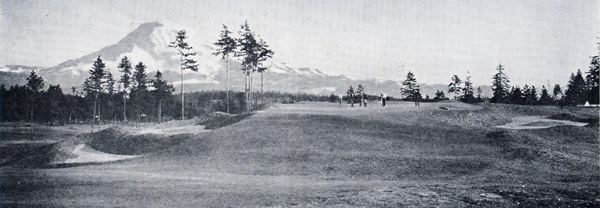 |
Here is what Fircrest Golf Club looked like in the 1920s, before the huge growth of trees blocked much of the scenery and sunlight. |
Trees definitely make growing grass more difficult.
They also grow. And grow. Little trees someone got free from a nursery become major problems in a few years time.
John Harbottle, the well-respected course architect from Tacoma, was asked to make some changes to the storied Los Angeles Country Club. He wanted to remove trees. The members said no. It wasn’t until he found photographs of the original course and demonstrated how much the growth of the trees had changed the course and the strategy needed to play it, did he begin to gain support for his tree removal idea.
MacKenzie warned about the use of trees to define holes. He talked about them like sentinel soldiers in a row. He cursed them.
I find one tree-lined fairway after another boring. Holes tend to look the same and there are only a few ways to escape should you violate the perimeter.
Perhaps I dislike trees because I absolutely relish links golf. At the same time, I love the big trees at Eugene Country Club, and Royal Oaks in Vancouver and Seattle Golf Club. They inspire and identify us.
Leave them be, if you can. But remember that golf is played on grass. And that our biggest need in the Northwest is sunlight, not shade.
Blaine Newnham is a former sports columnist and assistant managing editor for the Seattle Times. He covered the 1966 U.S. Open, following Ben Hogan around the Olympic Club. He covered his first Masters in 1987, when Larry Mize won it in a playoff with an unlikely chip shot. He covered the four majors of the “Tiger Slam”, when Woods won his four consecutive championships. In 2002, Blaine wrote a book titled “Golf Basics”.

